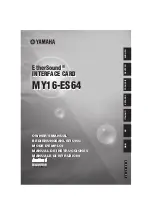
User's Guide HDSPe AIO
© RME
45
Using the cable adapter XLR/phono described above, devices with coaxial SPDIF interface can
be connected to the AES output of the AIO as well. Note that most consumer equipment with
phono SPDIF inputs will only accept signals having a Channel Status ‘Consumer’ format. In
such cases the above adapter cable will therefore not work.
23.3 SPDIF
Input
The SPDIF input (optical/coaxial) is configured in the Settings dialog, available by a click on the
hammer symbol in the Task Bar's system tray. The HDSPe AIO accepts all commonly used
digital sources as well as SPDIF and AES/EBU.
Output
Identical signals are available at both the optical and the coaxial output. An obvious use for this
would be to connect two devices, i.e. using the HDSPe as a splitter (distribution 1 on 2).
Apart from the audio data itself, digital signals in SPDIF or AES/EBU format have a header con-
taining channel status information. The HDSPe AIO ignores the received header and creates a
totally new one for its output signal.
Note that in record or monitor modes, a set emphasis bit will disappear.
The AIO’s SPDIF channel status has been implemented according to IEC60958:
•
32 / 44.1 / 48 kHz, 64 / 88.2 / 96 kHz, 176.4 / 192 kHz depending on the current sample rate
•
Audio use, Non-Audio
•
No Copyright, Copy Permitted
•
Format Consumer or Professional
•
Category General, Generation not indicated
•
2-channel, No Emphasis
•
Aux bits Audio Use
Operation as second AES/EBU I/O
Receiving signals in AES/EBU format requires a cable adapter. Pins 2 and 3 of a female XLR
plug are connected individually to the two pins of a phono plug. The cable shielding is only con-
nected to pin 1 of the XLR - not to the phono plug (see chapter 23.2).
Professional AES/EBU equipment can be connected to the HDSPe AIO thanks to the ‘Profes-
sional’ format option with doubled output voltage. The required cable is the same as the one for
the input, but with a male XLR plug instead of a female one.
23.4 MIDI
The HDSPe AIO offers one MIDI I/O via two 5-pin DIN connectors. The MIDI ports are added to
the system by the driver. Using MIDI capable software, these ports can be accessed under the
name
AIO MIDI
. Using more than one HDSPe AIO, the operating system adds a consecutive
number to the port name, like
AIO MIDI In (2)
etc.
The MIDI In port is available for both GSIF (GSIF-2 Low Latency) and standard MME MIDI si-
multaneously.
Summary of Contents for Hammerfall HDSPe AIO
Page 5: ...User s Guide HDSPe AIO RME 5 User s Guide HDSPe AIO General...
Page 12: ...12 User s Guide HDSPe AIO RME...
Page 13: ...User s Guide HDSPe AIO RME 13 User s Guide HDSPe AIO Driver Installation and Operation Windows...
Page 30: ...30 User s Guide HDSPe AIO RME...
Page 40: ...40 User s Guide HDSPe AIO RME...
Page 41: ...User s Guide HDSPe AIO RME 41 User s Guide HDSPe AIO Connections and TotalMix...
Page 47: ...User s Guide HDSPe AIO RME 47...
Page 69: ...User s Guide HDSPe AIO RME 69 User s Guide HDSPe AIO Technical Reference...
Page 79: ...User s Guide HDSPe AIO RME 79 31 Diagrams 31 1 Block Diagram HDSPe AIO...
















































